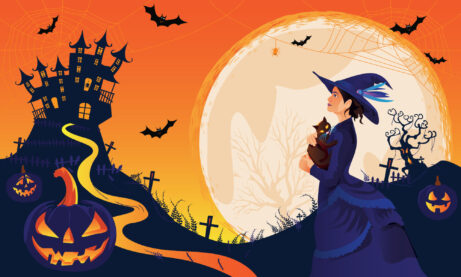Easter Traditions – Slovakia vs Britain
Prečítaj si článok o tradíciách spojených s Veľkou Nocou na Slovensku a v Británii. Sú naše tradície podobné alebo sa úplne líšia? Pod článkom nájdeš aj video o Britských tradíciách, ktoré si vieš vypočuť :)
Slovak Easter Traditions
Slovakia, a country nestled in the heart of Europe, boasts a rich history of cultural diversity and unique traditions. Among the various festivities, Easter holds a special place in the hearts of the Slovak people. This significant religious holiday, marking the resurrection of Jesus Christ, is celebrated with an array of delightful customs and traditions that have been passed down through generations. In this article, we will delve into the captivating world of Slovak Easter traditions, offering you an insider’s glimpse into the colorful tapestry of celebrations that have become synonymous with the arrival of spring.
- Palm Sunday: The Beginning of Holy Week
Easter celebrations in Slovakia commence with Palm Sunday, a week before Easter Sunday. In many villages and towns, people create and carry palm branches adorned with colorful ribbons, flowers, and sometimes even fruits. These decorative branches, known as ‚palmy,‘ symbolize the welcoming of Jesus into Jerusalem. The branches are taken to church to be blessed and later placed in homes, where they are believed to provide protection and prosperity throughout the year.
- The Great Fast: A Time for Spiritual Reflection
The Great Fast, or ‚Veľký pôst,‘ is a 40-day period of fasting and spiritual reflection observed by many devout Slovaks in preparation for Easter. During this time, many people abstain from meat and other indulgences to focus on prayer, meditation, and acts of charity. The Great Fast culminates on Holy Thursday with the tradition of ‚Zelený štvrtok,‘ or Green Thursday, when people consume green foods such as spinach, lettuce, or parsley to symbolize the start of a new life.
- Good Friday: A Day of Solemnity and Remembrance
On Good Friday, Slovaks commemorate the crucifixion of Jesus Christ with various rituals and customs. In many parts of the country, believers participate in somber processions, with some individuals carrying heavy wooden crosses to symbolize Jesus‘ sacrifice. Churches often hold special services, and families may gather to pray and reflect on the events leading up to Jesus‘ crucifixion.
- Easter Saturday: Preparing for the Big Day
Easter Saturday is a day filled with anticipation and preparation for the main event. Slovaks dedicate the day to cleaning their homes, preparing traditional Easter dishes, and decorating eggs. Known as ‚kraslice,‘ these intricately decorated eggs are a highlight of Slovak Easter customs. They are often adorned with elaborate patterns and motifs, using techniques such as wax-resist, scratching, or even embroidery.
- Easter Sunday: A Day of Rejoicing and Celebration
Easter Sunday in Slovakia is a day of joy and celebration. Families gather for a festive meal that often includes dishes such as roast lamb, ham, sausages, ‚šunka,‘ and ‚paska‘ (a type of sweet bread). Children eagerly search for hidden Easter eggs, while many people attend church services to celebrate the resurrection of Jesus Christ.
- Easter Monday: The Playful ‚Šibačka‘ Tradition
Easter Monday in Slovakia brings a unique and lively tradition known as ‚šibačka‘ or ‚oblievačka.‘ On this day, young men visit the homes of their female friends and relatives, where they playfully whip them with braided willow branches called ‚korbač.‘ This custom is believed to bestow health, beauty, and vitality upon the women. In return, the women reward the men with decorated eggs, sweets, and sometimes even a splash of cold water, which symbolizes purification and renewal.
Conclusion
Slovak Easter traditions are a vibrant blend of ancient customs, religious symbolism, and joyful celebrations. These age-old practices have been lovingly preserved and passed down through generations, providing a unique glimpse into the rich cultural heritage of Slovakia. From the solemnity of Good Friday to the playful rituals of Easter Monday, these traditions serve not only as a means to celebrate the resurrection of Jesus Christ but also as a testament to the enduring spirit of the Slovak people. As the world becomes increasingly interconnected, the preservation and appreciation of such cultural treasures become ever more vital. So, this Easter, whether you find yourself in Slovakia or simply want to explore the rich tapestry of traditions from afar, take a moment to immerse yourself in the captivating world of Slovak Easter customs and embrace the joy, renewal, and sense of community they represent.
British Easter Traditions
Easter is an important and cherished holiday in the United Kingdom, marking the resurrection of Jesus Christ and the arrival of spring. British Easter traditions are a delightful blend of religious observances and secular customs, creating a warm and inviting atmosphere for both young and old to enjoy. In this article, we will explore some of the most delightful and heartwarming British Easter traditions that make this time of year so special.
- Palm Sunday: The Start of Holy Week
Easter festivities in the UK begin with Palm Sunday, which takes place a week before Easter Sunday. On this day, Christians remember Jesus‘ triumphal entry into Jerusalem. Many churches hold special services where attendees are given small crosses made from palm leaves. These palm crosses are kept as a reminder of Jesus‘ sacrifice and the beginning of the Holy Week.
- Good Friday: A Day of Reflection and Tradition
Good Friday holds a significant place in British Easter celebrations, as it commemorates the crucifixion of Jesus Christ. Many people attend church services, and some even participate in solemn processions or re-enactments of the crucifixion. A popular Good Friday tradition is the consumption of hot cross buns, a spiced sweet bun marked with a cross on top. These buns symbolize the crucifixion and are typically enjoyed toasted with butter.
- Easter Egg Decorating and Hunts
One of the most beloved Easter traditions in the UK is decorating and hunting for Easter eggs. Eggs represent new life and have been associated with Easter celebrations for centuries. Children and adults alike enjoy painting hard-boiled eggs with bright colors and intricate patterns. Many communities, parks, and historic sites organize Easter egg hunts, where children search for hidden chocolate eggs and other treats.
- The Easter Bunny: A Symbol of Fertility and New Life
The Easter Bunny is a popular figure in British Easter celebrations, representing fertility and new beginnings. The concept of the Easter Bunny is thought to have originated from the Germanic goddess Eostre, who was associated with hares and the arrival of spring. Today, the Easter Bunny is a beloved character who brings chocolate eggs and other sweets to children on Easter morning.
- Simnel Cake: A Delicious Easter Treat
Simnel cake is a traditional British Easter dessert made from a rich fruitcake topped with marzipan. This festive cake is typically decorated with 11 marzipan balls, which represent Jesus‘ apostles, excluding Judas. Simnel cake has been a popular Easter treat since medieval times and is still enjoyed by many families across the UK during the holiday season.
- Easter Parades and Bonnets
Easter parades and bonnet-making are time-honored traditions in the UK. Women and children create elaborate, decorative hats called Easter bonnets, which are often adorned with flowers, ribbons, and other festive embellishments. Easter parades, where people showcase their creative bonnets, take place in various towns and cities across the country, adding a touch of charm and whimsy to the holiday celebrations.
Conclusion
British Easter traditions capture the essence of renewal, joy, and togetherness. With a mix of religious observances and fun-filled customs, Easter in the UK is a time for families to come together and create lasting memories. Whether it’s attending a solemn Good Friday service, participating in an exciting Easter egg hunt, or sharing a delicious slice of Simnel cake, the British Easter experience offers a heartwarming and vibrant celebration for all to enjoy.
Prihlás sa na odber noviniek
Takto ti neujde ani jeden článok, podcast či video. Neposielame žiaden spam, len užitočné informácie :) Odhlásiť sa vieš kedykoľvek.





